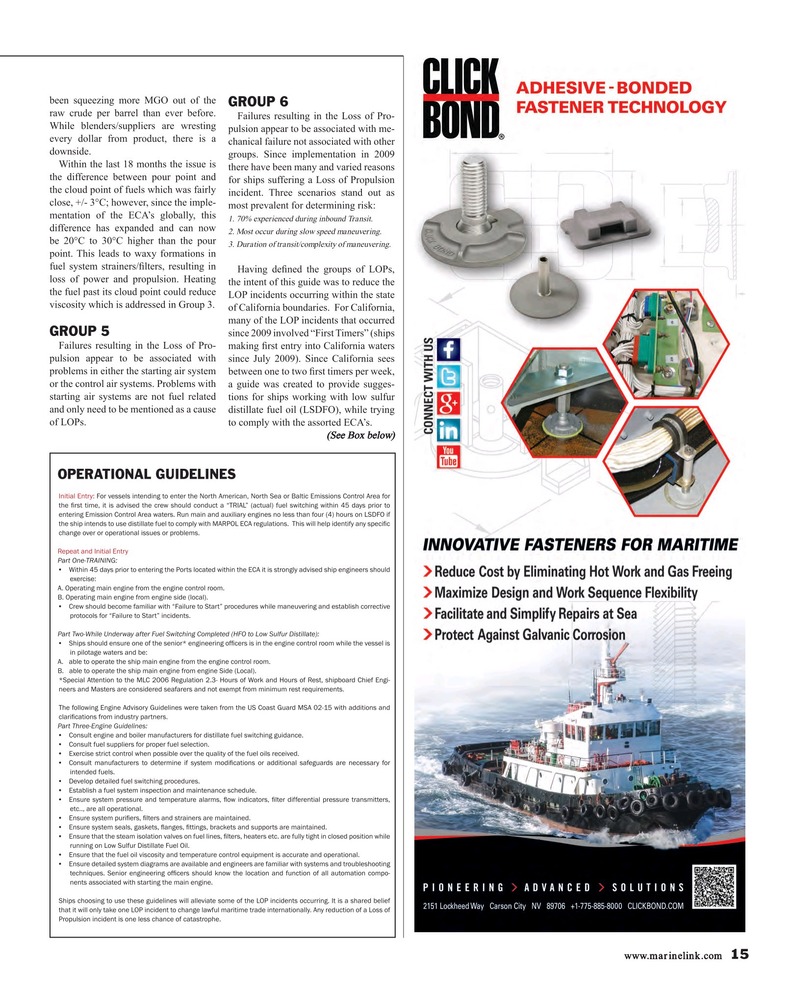
Page 15: of Maritime Reporter Magazine (July 2015)
Marine Communications Edition
Read this page in Pdf, Flash or Html5 edition of July 2015 Maritime Reporter Magazine
been squeezing more MGO out of the
GROUP 6 raw crude per barrel than ever before.
Failures resulting in the Loss of Pro-
While blenders/suppliers are wresting pulsion appear to be associated with me- every dollar from product, there is a chanical failure not associated with other downside. groups. Since implementation in 2009
Within the last 18 months the issue is there have been many and varied reasons the difference between pour point and for ships suffering a Loss of Propulsion the cloud point of fuels which was fairly incident. Three scenarios stand out as close, +/- 3°C; however, since the imple- most prevalent for determining risk: mentation of the ECA’s globally, this 1. 70% experienced during inbound Transit.
difference has expanded and can now 2. Most occur during slow speed maneuvering.
be 20°C to 30°C higher than the pour 3. Duration of transit/complexity of maneuvering.
point. This leads to waxy formations in fuel system strainers/? lters, resulting in
Having de? ned the groups of LOPs, loss of power and propulsion. Heating the intent of this guide was to reduce the the fuel past its cloud point could reduce LOP incidents occurring within the state viscosity which is addressed in Group 3.
of California boundaries. For California, many of the LOP incidents that occurred
GROUP 5 since 2009 involved “First Timers” (ships
Failures resulting in the Loss of Pro- making ? rst entry into California waters pulsion appear to be associated with since July 2009). Since California sees problems in either the starting air system between one to two ? rst timers per week, or the control air systems. Problems with a guide was created to provide sugges- starting air systems are not fuel related tions for ships working with low sulfur and only need to be mentioned as a cause distillate fuel oil (LSDFO), while trying of LOPs. to comply with the assorted ECA’s.
(See Box below)
OPERATIONAL GUIDELINES
Initial Entry: For vessels intending to enter the North American, North Sea or Baltic Emissions Control Area for the ? rst time, it is advised the crew should conduct a “TRIAL” (actual) fuel switching within 45 days prior to entering Emission Control Area waters. Run main and auxiliary engines no less than four (4) hours on LSDFO if the ship intends to use distillate fuel to comply with MARPOL ECA regulations. This will help identify any speci? c change over or operational issues or problems.
Repeat and Initial Entry
Part One-TRAINING: • Within 45 days prior to entering the Ports located within the ECA it is strongly advised ship engineers should exercise:
A. Operating main engine from the engine control room.
B. Operating main engine from engine side (local). • Crew should become familiar with “Failure to Start” procedures while maneuvering and establish corrective protocols for “Failure to Start” incidents.
Part Two-While Underway after Fuel Switching Completed (HFO to Low Sulfur Distillate): • Ships should ensure one of the senior* engineering of? cers is in the engine control room while the vessel is in pilotage waters and be:
A. able to operate the ship main engine from the engine control room.
B. able to operate the ship main engine from engine Side (Local).
*Special Attention to the MLC 2006 Regulation 2.3- Hours of Work and Hours of Rest, shipboard Chief Engi- neers and Masters are considered seafarers and not exempt from minimum rest requirements.
The following Engine Advisory Guidelines were taken from the US Coast Guard MSA 02-15 with additions and clari? cations from industry partners.
Part Three-Engine Guidelines: • Consult engine and boiler manufacturers for distillate fuel switching guidance.
• Consult fuel suppliers for proper fuel selection.
• Exercise strict control when possible over the quality of the fuel oils received.
• Consult manufacturers to determine if system modi? cations or additional safeguards are necessary for intended fuels.
• Develop detailed fuel switching procedures.
• Establish a fuel system inspection and maintenance schedule.
• Ensure system pressure and temperature alarms, ? ow indicators, ? lter differential pressure transmitters, etc.., are all operational.
• Ensure system puri? ers, ? lters and strainers are maintained.
• Ensure system seals, gaskets, ? anges, ? ttings, brackets and supports are maintained.
• Ensure that the steam isolation valves on fuel lines, ? lters, heaters etc. are fully tight in closed position while running on Low Sulfur Distillate Fuel Oil.
• Ensure that the fuel oil viscosity and temperature control equipment is accurate and operational.
• Ensure detailed system diagrams are available and engineers are familiar with systems and troubleshooting techniques. Senior engineering of? cers should know the location and function of all automation compo- nents associated with starting the main engine.
Ships choosing to use these guidelines will alleviate some of the LOP incidents occurring. It is a shared belief that it will only take one LOP incident to change lawful maritime trade internationally. Any reduction of a Loss of
Propulsion incident is one less chance of catastrophe. www.marinelink.com 15
MR #7 (10-17).indd 15 MR #7 (10-17).indd 15 7/6/2015 9:33:07 AM7/6/2015 9:33:07 AM

 14
14

 16
16
